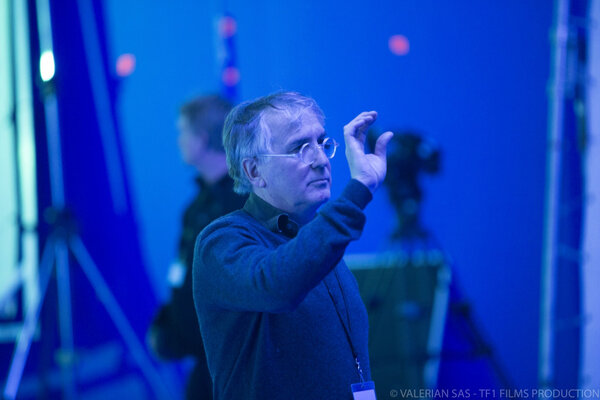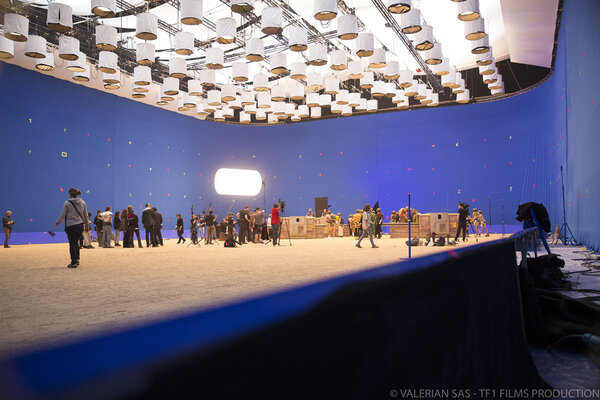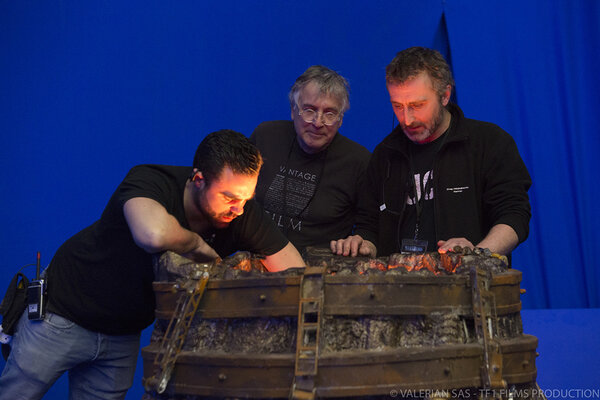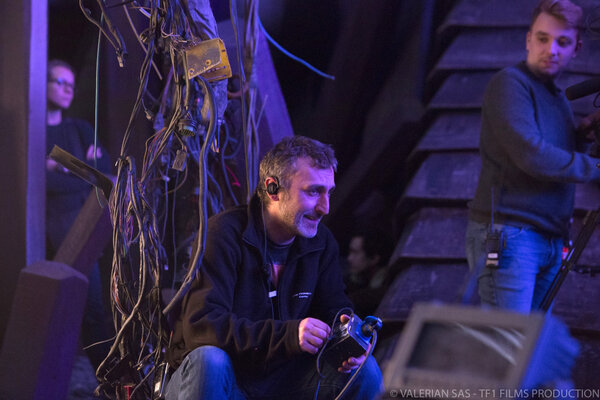“Valerian” and the thousand LEDs
Interview with Thierry Arbogast, AFC, conducted by François Reumont
“According to me,” explains Thierry Arbogast, “the major challenge was to incorporate almost all of the lighting into the sets in order to create “self-lit spaces” along with Hughes Tissandier, the production designer.” To accomplish this, the different teams involved needed over three months of preparation before shooting began.
“It was very different from what I am used to from working with Luc Besson on other films, on which I would arrive at most fifteen days before shooting began. On Valerian, Luc finalized each set with Hughes, and then I would create the lighting with them based on ideas, styles, and found objects that are based on each set and the infrastructure that we were able to incorporate into it. Sometimes I relied on mock-ups, but always emphasized flexibility and the ability to implement on set any staging idea that might come up.”
Before beginning this adventure, Arbogast performed a whole battery of tests with his camera crew. “We rented everything we could find related to LEDs from the renters, and we tested to make sure that the colorimetric space of each light source was appropriate to what we were doing. We did this not only to be able to run a technical check on each piece of equipment that the production design team and the gaffers were going to install on the sets being constructed, but also in order to make sure that all of the lights would mix properly once we were in the thick of things.”
For some sets, hundreds of metres of RGBW LED strips hooked up to a DMX console were used : “I loved being able to give Luc the possibility of choosing the exact tonality of any given ambience at the last minute. For example, in the cabaret scene, whose design is based on the transparencies and reflections of the different elements on the set, the predominating mauve colour could have been changed to almost any other colour just before saying “action” if necessary. What’s really convenient about RGBW LEDs is that you can easily achieve a very colourful and dynamic image, which is exactly what Luc wanted for this film.”
Even to light the actors’ faces, Luc didn’t hesitate to use LEDs : “I’ve been using a lightweight bicolour Light LED ring that can be attached to the lens and that you can modulate in intensity and colour by remote control. It’s an accessory that I used a lot on the close-ups on Scarlett Johansson in Lucy and that I used again on Valerian on a few special occasions, such as during a dark scene where the actor is falling down a chute and where the camera proceeds the character, which allowed me to maintain just the right level of shine on the face in function of the distance between the actor and the camera.”
Nonetheless, Arbogast also used more traditional light sources as required by the situation. “We didn’t want to do high-tech for high-tech’s sake,” he explains, “the choice of light source was done on a case-by-case basis, according to the needs of each scene. For example, we used a mix between 270 Space Lights hung on the ceiling of the Cité du Cinéma studios to create the ambient light for a desert planet along with Area 48 LED spots (with 5 500 K phosphoric panels) to create the illusion of a “sun” in space. This ambient light was very zenithal because of the Space Lights set up with white black-out skirts set to 3 200 K (2 lamps out of 3 were turned on) and a light that was projected onto the cold studio ceiling, which produces the effect of the type of shadows created by the sun at noon when the sky is azure blue.”

Gregory Fromentin, gaffer on this film, shares with us his experience filming in this “new generation” project that involves different skills and areas of expertise.

“This was one of the first times ever in France that a film used so many LEDs on a set,” explains Gregory Fromentin. “80% of the lighting on this film was integrated into the sets designed by Hugues Tissandier, with equipment that was entirely controllable by console able to instantly provide us with multiple lighting ambiences according to the needs of the different scenes.”
Armed with an Arri Skypanel (Transpalux) used to create the ambiences, about 40 Area 48s that were more easily moveable (Transpalux & Maluna) to light the green screens (with a dedicated chroma green phosphorus panel), and a series of DMGSL1s (Transpalux), the gaffer also relied on made-to-measure solutions that could be integrated into the spaceships and other futuristic sets on this film.
“Shooting begin in early January 2016 in a cabaret (a scene briefly seen in the trailer, in which the singer Rihanna makes an appearance), and I must say that in retrospect, we had very little time to prepare for such a challenge. Working with LEDs is really different from what was asked of a gaffer on a “regular” shooting where tungsten, fluorescent, or HMI spots are used. You’ve got to learn to use these new light sources and surround yourself with new expertise.
On Valerian, I teamed up with console specialists Frédéric Fayard and Aldo of ConceptK who usually deal with big concerts or choreography events. They have been part of my team since Star 80 and Lucy, two films in which techniques that came from the theatre (like automatic spots) were combined with the more classic cinematographic techniques.”
Combining simultaneously equipment and technology from the world of architectural lighting (via Christophe Grisoni of Led Box), Gregory Fromentin also had to meet the challenge of a series of camera tests in order to evaluate the LEDs dimming capacities and ensure there was no flicker.
“During the month of December2015, we intensively tested the equipment intended to control the hundreds of meters of LED strips that had just been ordered for the sets.
Henrik Moseid had supplied us with a dozen completely flicker-free high frequency dimmers that were attached to rolls of Softlight LED strips in RGBW. Attached to the DMX console, each Softlight LEDimmer allowed us to control the light intensity and colour down to the percent during each take. Of course, LED strips aren’t as long-lasting as other equipment, and we sometimes had to change them out during shooting, but the flexibility with which they can be integrated into a set, the precision of their adjustability, and the quality of light they produce is all there.”
Shooting intensified in Spring 2016 (42 sets and 20 weeks of shooting schedule) and during that time, Gregory Fromentin became more comfortable with the setup and was even able to create made-to-measure light sources for Thierry Arbogast. “On a film by Luc Besson, I can say that there aren’t a lot of spots on stands or flags, there just isn’t the time when you’re filming 40 shots per day. We found Chimera Octoplus with Pascal Lombardo which had been originally designed for Jokers. Full of tubes stuffed with Softlight RGBW LED strips and set on a dimmer, these spots became one of the rare tools we used frontally.”
Another example of the use of LED strips : a scene where Dane De Haan (Valerian) is attached to a mauve ball of light floating in space. “For that scene, Thierry Arbogast asked me to cover tennis balls with LED strips, which, once they were set to the mauve colour of the ball, allowed us to create a credible effect of space light on him.”

“Valerian was a unique experience for me,” notes Gregory Fromentin. “Working on a project of such size is rare in France, and having to work alongside teams from across the globe, like the New Zealanders from Weta Digital (who were also in charge of Lord of the Rings) was really exciting. Over one hundred VFX technicians were on site at the Cité du Cinéma with the challenges in terms of data exchange and networks that that presented, and the extreme precision that some of the motion control scenes required.
A lot of things were filmed on a blue screen, whether it be additions to the light sources or entire scenes where everything was recreated synthetically. At those times, the collaboration between the camera, light, grip, and VFX teams was really great.”
(Interview conducted by François Reumont for the AFC, and translated from French by Alexander Baron-Raiffe)
 En
En Fr
Fr





